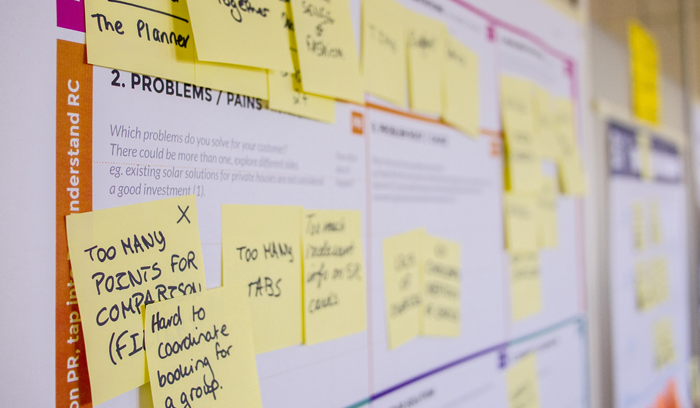
Methodologies are sets of principles, procedures and techniques that help set up a functional project management process. Since there’s a wide range of them, the problem of choice is what many are facing.
Choosing the right methodology for projects you manage saves time and helps organize an efficient process. While each project requires individual modifications of existing methods and there’s no “plug-and-play” solution, there are general recommendations on how to find out what project management methodologies are right for a project, depending on the scale of the specific project and the industry you’re working in.
Agile
Agile, while being not exactly a methodology, is a popular customer-focused approach that emphasizes engagement, collaboration and customer satisfaction rather than rigid procedures and strict rules. It suggests teams’ self-management, acting in line with changing customers’ needs, quickly adapting to project changes, and iteratively delivering solutions.
- Orientation to customers’ expectations
- Providing business value
- Easily adapting to changes
- Customers need to commit significant time to feedback and analysis
- No strict plans and no long-term goals cause scope creep
- Orientation to customers’ expectations
- Providing business value
- Easily adapting to changes
- Customers need to commit significant time to feedback and analysis
- No strict plans and no long-term goals cause scope creep
Team size: small teams
Project features: small to medium projects with highly dynamic environments
Industries: software development, engineering, advertising, consulting
Scrum
Scrum is a lightweight “flavor” of the Agile approach. It offers ways to improve project delivery and use time and budget more efficiently. While being flexible enough, it suggests a detailed structure of work. According to Scrum methodology, a product backlog (basically a “wish list” of tasks) is created, work is divided into short periods (sprints), and stakeholders and product owners review results at the end of each sprint.
- High efficient use of time and budget
- Simplifies management procedure
- Ensures clear visibility
- Increases flexibility and makes changes easier
- High risk of scope creep
- Works well with experienced scrum teams only
- High cost of replacement if a team member leaves the team
- High efficient use of time and budget
- Simplifies management procedure
- Ensures clear visibility
- Increases flexibility and makes changes easier
- High risk of scope creep
- Works well with experienced scrum teams only
- High cost of replacement if a team member leaves the team
Team size: small teams
Project features: small, medium and large projects with changing requirements (however scope creep is possible for larger projects)
Industries: software development
Lean
Lean is a methodology based on the Toyota production system and focused on process efficiency: it’s about cutting out everything that is dysfunctional or just not essential, and delivering the product sooner. While saving time and money, Lean methodology also helps create transparent communication and ensure quality.
- Creates a functional environment
- Saves time and budget
- Simplifies monitoring of process and results
- Risk of not meeting customers’ expectations due to rigid environment
- Requires excellent documentation of all procedures and requirements
- Creates a functional environment
- Saves time and budget
- Simplifies monitoring of process and results
- Risk of not meeting customers’ expectations due to rigid environment
- Requires excellent documentation of all procedures and requirements
Team size: medium to large teams
Project features: projects of any size with limited time, budget and resources
Industries: manufacturing, construction, engineering, software development
Kanban
Kanban is associated with Agile methods and offers a way to organize and optimize the Agile work process. Basically, the process is divided into specific steps and work is moved between them from start to delivery. This increases efficiency and reduces time and effort spent on following formal procedures.
- Accurate visual model of work process
- Less formality and more efficiency
- Clarity and transparency of work steps
- No strategic vision
- High risk of scope creep
- Hard to enforce Work in Progress limits
- Accurate visual model of work process
- Less formality and more efficiency
- Clarity and transparency of work steps
- No strategic vision
- High risk of scope creep
- Hard to enforce Work in Progress limits
Team size: small to large teams
Project features: projects of any size that need to combine agility and strictly defined work steps
Industries: manufacturing, engineering, software development
Scrumban
As the name of the methodology suggests, it combines Scrum and Kanban features to bring in the best of both approaches. Scrumban mixes Kanban flexibility and Scrum structure to adapt to dynamic environments and deliver projects on time.
- Ensures timely project delivery
- Works well in highly dynamic environments
- High visibility and transparency
- Sacrifices minor features to complete essential ones on time
- Doesn’t provide long-term vision
- Ensures timely project delivery
- Works well in highly dynamic environments
- High visibility and transparency
- Sacrifices minor features to complete essential ones on time
- Doesn’t provide long-term vision
Team size: small to medium teams
Project features: projects of any size where unexpected changes to requirements and priorities are possible
Industries: software development
Extreme Programming
Extreme Programming (XP) methodology shares all Agile principles: customer satisfaction, changes based on feedback, multiple modifications, and highly collaborative teams. Among the technical practices it prescribes to raise productivity, pair programming and planning games are worth mentioning. XP is also based on iterative cycles – they usually last one week and therefore require high productivity levels within the team.
- Significant cost reduction due to focus on coding rather than on formal procedures
- Reduces risks by mitigating the dependence on individuals
- Improves code quality
- Doesn’t work well in complex environments and large projects
- Weak quality measurement
- Is not comfortable for newcomers
- Doesn’t work well for remote and distributed teams
- Significant cost reduction due to focus on coding rather than on formal procedures
- Reduces risks by mitigating the dependence on individuals
- Improves code quality
- Doesn’t work well in complex environments and large projects
- Weak quality measurement
- Is not comfortable for newcomers
- Doesn’t work well for remote and distributed teams
Team size: small teams
Project features: small to medium projects with volatile environments
Industries: software development
Waterfall
Waterfall methodology provides a clear and rigid structure of work. It prescribes planning project phases before any works start, and work on the next phase after the previous one is accomplished. Review and feedback is obtained after development and testing phases are completed.
- Very clear and well-defined functions
- Predictable work process and scope
- Long-term goals are visible
- Changes are expensive and cannot be implemented instantly
- Client’s feedback cannot be included in the work scope before development is finished
- Elaborate documentation is required, which increases work costs
- Very clear and well-defined functions
- Predictable work process and scope
- Long-term goals are visible
- Changes are expensive and cannot be implemented instantly
- Client’s feedback cannot be included in the work scope before development is finished
- Elaborate documentation is required, which increases work costs
Team size: medium to large teams
Project features: projects of any size where environment is predictable and changes are unlikely
Industries: manufacturing, construction, software development
PRINCE2
PRINCE2 (acronym for Projects in Controlled Environments) methodology covers management, monitoring and organization of project work. This methodology was originally created in the UK and approved as a government standard for projects in information technology field. It includes six variables: costs, timescales, quality, scope, risk, and benefits. The method is focused on business justification, agility, stakeholder involvement on all phases, and continuous improvement.
- Clearly defined framework
- Increased performance
- Better quality of end products
- Changes can require significant time for the team to adapt
- Processes are heavily documented and therefore cumbersome
- High efficient use of time and budget
- Simplifies management procedure
- Ensures clear visibility
- Increases flexibility and makes changes easier
- High risk of scope creep
- Works well with experienced scrum teams only
- High cost of replacement if a team member leaves the team
Team size: teams of any size
Project features: medium to large projects where changes are not expected and thorough phasing and detailed documentation are required
Industries: software development, advertising, consulting, engineering
PMI’s PMBOK
PMBOK (Project Management Body of Knowledge) is not exactly a methodology – it’s a set of universal standards developed by Project Management Institute. It describes project management principles, best practices, processes, and methods. Basically, it’s built around the sequential methodology that is commonly known as Waterfall and describes the principles of a plan-driven approach. This knowledge is basic for any project manager and is useful regardless of the methodology you’re using to manage projects.
Summary
As essential as it is to choose the right methodology, the key point is adapting existing methods and techniques to your project, environment and work culture, instead of sticking to theoretical principles. Each project is unique, and while it’s not easy to find a ready-to-use solution, methodologies can be used as a set of basic principles and practices that match your purposes best.

















































